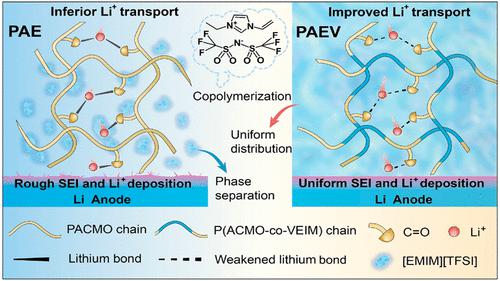Our official English website, www.x-mol.net, welcomes your
feedback! (Note: you will need to create a separate account there.)
Modulating the Coordination Environment of Lithium Bonds for High Performance Polymer Electrolyte Batteries
ACS Nano ( IF 15.8 ) Pub Date : 2023-02-06 , DOI: 10.1021/acsnano.2c11734 Zhilong Tian 1 , Lei Hou 1 , Doudou Feng 1 , Yucong Jiao 1 , Peiyi Wu 1, 2, 3
ACS Nano ( IF 15.8 ) Pub Date : 2023-02-06 , DOI: 10.1021/acsnano.2c11734 Zhilong Tian 1 , Lei Hou 1 , Doudou Feng 1 , Yucong Jiao 1 , Peiyi Wu 1, 2, 3
Affiliation

|
The new-generation lithium metal batteries require polymer electrolytes with high ionic conductivity and mechanical properties. However, the performance of the polymer electrolytes is severely influenced by the lithium bond formation between the functional groups and lithium ions (Li+), which has barely been considered in the past. Herein, a lithium bond enriched polymer gel (PAEV) is elaborately designed by copolymerizing 4-acryloylmorpholine (ACMO) and 1-vinyl-3-ethyl imidazolium bis(trifluoromethylsulfonyl)imide ([VEIM][TFSI]) in 1-ethyl-3-methyl imidazolium bis(trifluoromethylsulfonyl)imide ([EMIM][TFSI]) with the presence of LiFSI. The lithium bonds formed between LiFSI and carbonyl groups in PACMO can be regulated by the Li+ coordination number, and further weakened by the hydrogen bonds with [EMIM][TFSI] and poly[VEIM][TFSI], to effectively render the polymer electrolyte with adjustable ionic conductivity and tunable mechanical property. In addition, with the regulated coordination environment of Li+, the LiF and Li3N layer can be uniformly formed on the Li surface to facilitate Li+ nucleation and deposition. As a consequence, the PAEV electrolyte confers the Li/LiFePO4 (LFP) battery with high capacity of 124 mA h g-1 at 1 C under 25 °C, and 152 mA h g-1 under 50 °C. This work can promote the development of high performance polymer electrolyte via lithium bond manipulation.
更新日期:2023-02-06































 京公网安备 11010802027423号
京公网安备 11010802027423号